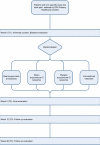Efficacy and safety of acupuncture for the treatment of non-specific acute low back pain: a randomised controlled multicentre trial protocol [ISRCTN65814467]
- PMID: 16630342
- PMCID: PMC1468427
- DOI: 10.1186/1472-6882-6-14
Efficacy and safety of acupuncture for the treatment of non-specific acute low back pain: a randomised controlled multicentre trial protocol [ISRCTN65814467]
Abstract
Background: Low back pain and its associated incapacitating effects constitute an important healthcare and socioeconomic problem, as well as being one of the main causes of disability among adults of working age. The prevalence of non-specific low back pain is very high among the general population, and 60-70% of adults are believed to have suffered this problem at some time. Nevertheless, few randomised clinical trials have been made of the efficacy and efficiency of acupuncture with respect to acute low back pain. The present study is intended to assess the efficacy of acupuncture for acute low back pain in terms of the improvement reported on the Roland Morris Questionnaire (RMQ) on low back pain incapacity, to estimate the specific and non-specific effects produced by the technique, and to carry out a cost-effectiveness analysis.
Methods/design: Randomised four-branch controlled multicentre prospective study made to compare semi-standardised real acupuncture, sham acupuncture (acupuncture at non-specific points), placebo acupuncture and conventional treatment. The patients are blinded to the real, sham and placebo acupuncture treatments. Patients in the sample present symptoms of non specific acute low back pain, with a case history of 2 weeks or less, and will be selected from working-age patients, whether in paid employment or not, referred by General Practitioners from Primary Healthcare Clinics to the four clinics participating in this study. In order to assess the primary and secondary result measures, the patients will be requested to fill in a questionnaire before the randomisation and again at 3, 12 and 48 weeks after starting the treatment. The primary result measure will be the clinical relevant improvement (CRI) at 3 weeks after randomisation. We define CRI as a reduction of 35% or more in the RMQ results.
Discussion: This study is intended to obtain further evidence on the effectiveness of acupuncture on acute low back pain and to isolate the specific and non-specific effects of the treatment.
Similar articles
-
Efficacy and safety of thread embedding acupuncture combined with conventional acupuncture for chronic low back pain: A study protocol for a randomized, controlled, assessor-blinded, multicenter clinical trial.Medicine (Baltimore). 2018 May;97(21):e10790. doi: 10.1097/MD.0000000000010790. Medicine (Baltimore). 2018. PMID: 29794761 Free PMC article. Clinical Trial.
-
Auricular acupuncture for primary care treatment of low back pain and posterior pelvic pain in pregnancy: study protocol for a multicentre randomised placebo-controlled trial.Trials. 2014 Jul 16;15:288. doi: 10.1186/1745-6215-15-288. Trials. 2014. PMID: 25027493 Free PMC article. Clinical Trial.
-
Efficacy, safety, and cost-effectiveness analysis of adjuvant herbal medicine treatment, Palmijihwang-hwan, for chronic low back pain: a study protocol for randomized, controlled, assessor-blinded, multicenter clinical trial.Trials. 2019 Dec 27;20(1):778. doi: 10.1186/s13063-019-3776-7. Trials. 2019. PMID: 31882016 Free PMC article.
-
Complementary and alternative therapies for back pain II.Evid Rep Technol Assess (Full Rep). 2010 Oct;(194):1-764. Evid Rep Technol Assess (Full Rep). 2010. PMID: 23126534 Free PMC article. Review.
-
Acupuncture and related interventions for the treatment of symptoms associated with carpal tunnel syndrome.Cochrane Database Syst Rev. 2018 Dec 2;12(12):CD011215. doi: 10.1002/14651858.CD011215.pub2. Cochrane Database Syst Rev. 2018. PMID: 30521680 Free PMC article.
Cited by
-
Acupuncture for acute non-specific low back pain: a protocol for a randomised, controlled multicentre intervention study in general practice--the Acuback Study.BMJ Open. 2012 Jun 25;2(3):e001164. doi: 10.1136/bmjopen-2012-001164. Print 2012. BMJ Open. 2012. PMID: 22734119 Free PMC article.
-
The immediate effects of local and adjacent acupuncture on the tibialis anterior muscle: a human study.Chin Med. 2008 Dec 18;3:17. doi: 10.1186/1749-8546-3-17. Chin Med. 2008. PMID: 19094211 Free PMC article.
-
Acupuncture therapy for chronic low back pain: protocol of a prospective, multi-center, registry study.BMC Musculoskelet Disord. 2019 Oct 27;20(1):488. doi: 10.1186/s12891-019-2894-4. BMC Musculoskelet Disord. 2019. PMID: 31656194 Free PMC article.
-
Traditional Chinese medicine for neck pain and low back pain: a systematic review and meta-analysis.PLoS One. 2015 Feb 24;10(2):e0117146. doi: 10.1371/journal.pone.0117146. eCollection 2015. PLoS One. 2015. PMID: 25710765 Free PMC article.
References
-
- van Tulder MW, Waddell G. Evidence-based medicine for non-specific low back pain. Best Pract Res Clin Rheumatol. 2005;19:vii–vix. doi: 10.1016/j.berh.2005.03.009. - DOI


